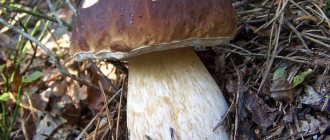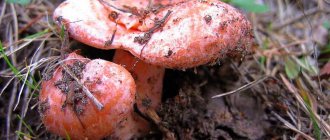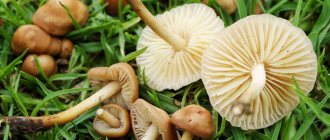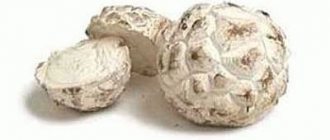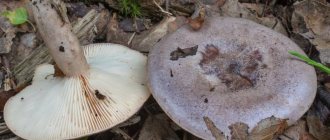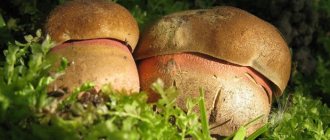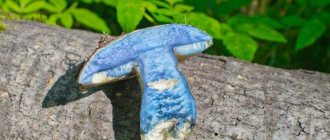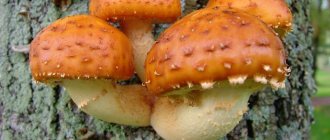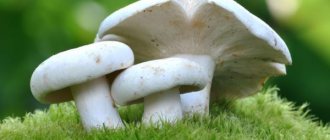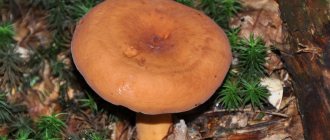Milky mushrooms are all edible mushrooms. Among them there are especially aromatic and tasty ones, for example, wood milkweeds, distinguished by the extraordinary contrast of the colors of the cap and the blades. However, they all require pre-soaking before final salting.
The first of the lacticifers to grow in June are the non-caustic and pale yellow lacticaria. All laticifers are edible and can be distinguished by the presence of juice at the cut or broken points. However, they, like milk mushrooms, become edible after preliminary soaking to remove bitterness. They grow in groups.
September milkies occupy larger spaces compared to August ones, getting closer and closer to swampy areas, rivers and canals.
In October, the milkweeds change color greatly after the first frost. This change is so strong that it can be difficult to distinguish between them. Only those milkweeds that have not changed their appearance and properties under the influence of frost can be used for food, soaked and salted.
Milky plants hot-milky and camphor
Milky-searing milky in the photo
The color of the cap is gray-flesh or gray-olive (photo)
The stinging milkweed is a rare lamellar mushroom that grows singly or in small groups from early August to early October. It prefers to settle on clay soils or in open, illuminated areas of mixed, deciduous and broad-leaved forest, as well as in bushes.
The mushroom is edible. The cap is 3-6 cm, smooth, slightly concave, first with a rolled-up edge, then with an unfolded sharp edge, sometimes with drops of milky juice. The color of the cap is gray-flesh or gray-olive with faint concentric circles. In wet weather the cap is slimy. Descending thin ocher-yellow plates with droplets of milky juice. The milky juice is pungent, abundantly white, and does not change color in air. The stem of mature mushrooms is hollow, the same color as the cap or lighter, up to 5 cm long. Its surface is smooth, matte, dry, yellowish-brown. There is a lighter transverse stripe near the cap on the stem. The pulp is dense, white or grayish with a faint mushroom odor. The milky juice is bitter, white in color, which does not change upon contact with air.
Grows next to hazel and other species.
Found from August to October.
The stinging milky milky has no poisonous counterparts.
The stinging milky milkweed belongs to the third category. Suitable only for pickling, but after pre-boiling.
Camphor milkweed in the photo
Camphor milkweed is a fairly rare edible agaric mushroom that grows exclusively in small groups from mid-July to early October. A high-yielding species that bears fruit abundantly, regardless of weather conditions. Loves moist areas of soil at the foot of trees in coniferous, deciduous and mixed forests.
The mushroom cap is convex-tubercular, eventually turning into a funnel-shaped one, retaining a small tubercle in the middle. The edge of the cap is wavy and slightly ribbed.
The diameter is about 5 cm. The surface of the cap is smooth, dry, matte, reddish-brown or dark red, with a purple-burgundy middle. The spore-bearing plates are narrow, adherent, first pinkish-yellow, and then brownish.
As you can see in the photo, the leg of this species of milkweed is rounded, straight, less often curved, in young mushrooms it is solid, in mature ones it is hollow:
Its height is about 5 cm, and its diameter is about 0.5 cm. The surface of the leg is smooth, matte, and white-pubescent at the base. It is painted the same color as the cap, but the bottom is purple-red. The pulp is thin, brittle, tender, reddish-brown in color, tasteless, with a characteristic smell of camphor. The milky juice is white and does not change upon contact with air.
Camphor milkweed belongs to the second category. It is best used as food in salted form.
Milkies are sticky and grey-pink
The milkies are sticky in the photo
The pulp is white, dense, with a peppery taste.
The sticky milkweed is conditionally edible . The cap is 5-10 cm, convex, with curled edges, later slightly depressed, with a dimple in the center, slimy when moistened, sticky in dry weather, olive, gray or brownish. The plates are white, often located, slightly descending, with drops of milky juice. The stem is 5-8 cm long, 1-2 cm thick, dense, hollow, lighter than the cap. The milky juice is white, abundant, and turns olive green when exposed to air. The pulp is white, dense, with a peppery taste.
Grows in deciduous and coniferous forests.
Found from July to September.
The sticky milky has no poisonous counterparts.
Pre-soaking is required. Suitable for cold pickling. With prolonged cold salting of bitter and caustic milkweeds, lactic acid fermentation occurs, which reduces the pungency and makes it more pleasant.
Milky gray-pink in the photo
Gray-pink milkweed is a rather rare, lamellar mushroom , in some reference books referred to as inedible milk mushroom or roan milkmilk. It grows in small groups or numerous colonies, forming bunches, from the second half of July to the beginning of October. As its main habitat, it prefers mossy areas of soil in pine or mixed forests, as well as blueberry thickets and the surrounding swamps.
The mushroom is inedible. The cap is 10-15 cm, concave, dry, matte, finely scaly, at first flat with a tucked edge, then spread, widely depressed, funnel-shaped with a wavy curved edge.
Pay attention to the photo - this type of milk mushroom has a gray-pink, pinkish-beige, yellowish or brownish cap with a darker middle without concentric zones:
The plates are brittle, narrow, descending, first yellowish, then pink-ocher. The stem is up to 8 cm high, cylindrical, colored in the color of the cap; in old mushrooms, the stem is hollow, pubescent with mycelium in the lower part. The pulp is dense, brittle, not burning, pinkish-yellow or orange when freshly cut, with a strong spicy smell of hay and dried mushrooms. The milky juice is colorless, not hot. In certain weather, the funnels of old mushrooms and moss nearby are covered with white-pink spore powder
It grows among mosses in pine forests with high peat soil.
It has no poisonous counterparts, but can be confused with the burning-caustic Molokankas.
It differs from them in its colorless, non-burning juice.
Reproduction and development
The smooth bug is an insect with incomplete metamorphosis. Its development includes three stages
- Egg. At the beginning of spring, the female mates with the male, after which she lays up to 200 yellow eggs on the lower part of aquatic plants.
- Larva. After about two weeks, the eggs hatch into larvae. They look like adult insects, but are wingless and light green in color. During the summer, three molts occur, with each one the structure of the young bug changes slightly - in the last molt, the rudiments of wings already appear.
- Imago. By August, the bug molts for the fourth time and becomes an adult insect. Its development ends here, but the chitinous cover hardens and acquires its final color only after some time.
Smooth bug larvae resemble adult bedbugs in structure, but are much lighter in color and do not have wings
The milkies are zoneless and pale
Zoneless milkman in the photo
The cap is flat, with a depression in the center (photo)
The zoneless milky plant (Lactarius azonites) has a cap with a diameter of 3–8 cm. The cap is dry, matte. Grey, nut-gray in color, covered with small spots of a lighter shade. Ivory colored plates. When damaged, the pulp and plates take on a reddish-coral tint. The milky juice is white, slightly pungent.
The stem is 3–8 cm high, up to 1.5 cm in diameter, white, creamy at maturity, initially filled, later hollow, fragile.
Spore powder. Whitish.
Habitat. In deciduous forests, it prefers oak.
Season. Summer autumn.
Similarity. Similar to some other milkweeds, but distinguished by a gray cap without zones and a coral color of damaged flesh.
Use. Most likely inedible, in some Western sources it is characterized as suspicious.
Pale milkweed in the photo
The surface of the cap is smooth, matte, dry.
Pale milkweed (Lactarius pallidus) is a rare conditionally edible agaric mushroom that grows singly or in small groups from mid-July to late August in deciduous and mixed forests. It is distinguished by its stable yield, independent of weather conditions.
Its surface is usually smooth, but it can also be cracked, shiny, covered with a thin layer of sticky mucus, and colored yellowish or fawn. The spore-bearing plates are narrow, the same color as the cap. The leg is round, straight, smooth or thinner at the base, hollow inside, about 9 cm high with a diameter of only about 1.5 cm. The pulp is thick, fleshy, elastic, white or cream in color, with a pleasant mushroom aroma and bitter, but not acrid taste. It produces a large amount of white milky juice, which does not change color when in contact with air.
Pale milkweed belongs to the third category of mushrooms. Soaking in cold water or boiling deprives its pulp of bitterness, as a result of which the mushrooms can be used for pickling.
Spore powder. Light ocher.
Habitat. In deciduous forests, it prefers beech and oak.
Season. Summer autumn.
Similarity. With pepper milk mushroom (L. piperatus), but it has a very acrid milky juice that turns gray-green in air.
Use. The mushroom can be salted.
This video shows lacticians in their natural habitat:
Interesting Facts
The common milkweed is characterized by a number of interesting features:
- In a number of European countries, this mushroom is considered inedible.
- On Russian territory, milkweeds are traditionally used for salting.
- In terms of nutritional properties, milkweeds are better than meat (at least in terms of protein content).
- At the same time, milkweed contains few calories, so it is a dietary product.
The common milkweed is a completely edible mushroom, but traditionally it is considered conditionally edible, since its fruiting body contains bitter juice. To get rid of bitterness, it is recommended to soak or boil it.
Preschool children should not be given mushrooms to eat due to the immaturity of their digestive tract, as well as people with diseases of the stomach and intestines, since mushrooms are generally poorly digested.
It should also be remembered that mushrooms often cause allergic reactions, so allergy sufferers should take special precautions when consuming them.
Oak and lilac milkmen
Oak milkweed in the photo
Lactarius quietus in the photo
Oak milkweed ( Lactarius quietus ) has a cap with a diameter of 5–8 cm . The cap is first flat-convex, later funnel-shaped. The skin is dry, slightly sticky in wet weather, reddish-brown, reddish-brown with vague concentric zones. The plates are adherent or slightly descending, frequent, light brown, becoming brick-reddish with age. The pulp is light brown, brittle, the milky juice is whitish, and does not change color in air. The taste is soft, bitterish when ripe, the smell is slightly unpleasant, bug-like.
The stem is 3–6 cm high, diameter 0.5–1.5 cm, cylindrical, smooth, hollow, the same color as the cap, rusty-brown at the base.
Spore powder. Yellowish-ocher.
Habitat. In deciduous forests, next to oak trees.
Season. July – October.
Similarity. With milkweed (L. volemus), which is distinguished by its abundant white milky juice and herring smell.
Use. Edible, can be salted.
Lilac milky in the photo
(Lactarius uvidus) in the photo
The lilac milky (Lactarius uvidus) has a cap with a diameter of up to 8 cm. The cap is at first convex, later spread out and even depressed in the center, in wet weather it is slimy. The edges are rolled up, slightly pubescent. Color light gray, gray-violet, yellowish-violet. The plates are whitish-pink. The pulp and plates become purple when damaged. At the fracture, white milky juice is released, which also changes color to purple. The taste is pungent, the smell is inexpressive.
The leg is up to 7 cm high, up to 1 cm in diameter, cylindrical, slightly tapering towards the base, dense, sticky.
Spore powder. White.
Habitat. In deciduous forests, it prefers willows and birches.
Season. Summer autumn.
Similarity. It is similar to the lilac or dog milk mushroom (L. repraesentaneus), which grows in coniferous and mixed forests, mainly in the mountains, and has a large size, a yellow cap with a shaggy edge and an almost fresh taste.
Use. Consumed salted after soaking or boiling.
Milkworms non-caustic and common
The non-caustic milkweed in the photo
The hat is smooth, bright orange (photo)
The non-caustic milkweed is a rare conditionally edible agaric mushroom that grows singly or in small groups from mid-July to the end of October. Peak yields occur in August-September. Most often found on mossy soil areas or covered with a thick layer of fallen leaves in mixed and coniferous forests.
The mushroom cap is first convex, then prostrate and depressed, with thin wavy edges. Its diameter is about 8 cm. The surface of the cap is smooth, moist, bright orange, more saturated in the center. The spore-bearing plates are wide, adherent, pure yellow, on which small red spots appear over time.
The stem is round, at first solid, then cellular and finally hollow, about 8 cm high and about 1 cm in diameter. The surface is smooth, matte, the same color as the cap. The pulp is thin, brittle, tender, tasteless and odorless, white with a slight orange tint. Compared to other laticifers, the milky sap is released less abundantly. When in contact with air, its color does not change.
The non-caustic milkweed belongs to the fourth category of mushrooms. After preliminary soaking or boiling, young mushrooms can be pickled.
Spore powder. Yellowish.
Habitat. In deciduous and coniferous forests, usually in groups.
Season. Summer autumn.
Similarity. With oak milkweed (L. quietus), which has a brownish color and unclear concentric zones on the cap.
Use. You can add salt after boiling.
Common milkweed in the photo
(Lactarius trivialis) in the photo
The common milkweed, Gladysh (Lactarius trivialis) has a cap with a diameter of 5-20 cm. The cap is at first convex, later it becomes flat or flat-depressed. The skin is sticky, shiny and smooth when dry. The color is initially leaden or violet-gray, later pinkish-brownish, gray-pink-yellowish, almost without zones, sometimes with spots or circles along the edge. The plates are thin, adherent or slightly descending, cream-colored, later yellowish-pink. The milky juice is white, caustic, and in air gradually acquires a grayish-green color. The pulp is brittle, whitish, under the skin with a gray-violet tint, the smell is fruity.
Leg. Height 4–7 cm, diameter 2–3 cm, cylindrical, mucous, hollow. The color is grayish-yellow or almost white.
Spore powder. Yellowish.
Habitat. In damp coniferous and mixed forests, sometimes in large colonies.
Season. August – October.
Similarity. With silverweed (L. flexuosus), which has a dry cap and a solid stem; with the lilac milkweed (L. uvidus), whose milky sap turns purple in air.
Use. The mushroom is edible and suitable for pickling after soaking or boiling.
Cooking Recipes
Common milkweed is classified as a conditionally edible mushroom of the second category. When salted, it acquires a pleasant sourish taste, which distinguishes it from many other mushrooms. After salting it becomes bright yellow.
Primary processing
First, the fruits should be cleared of forest debris, inspected for rot and, if found, removed. The milkweed is not affected by worms, and therefore there is no need to worry about them
An important part of the preliminary preparation of smoothie is soaking it. The procedure lasts a day, and the water is changed at least 5 times during this period.
After this, the laticifers are ready for further processing.
Pickling
In order to marinate 2 kg of smoothies, you will need:
- water – 1 l;
- salt – 20 g.
For the marinade:
- vinegar – 120 ml;
- salt – 2 tsp;
- sugar – 1 tsp;
- allspice peas – 3 pcs.;
- laurel – 2 leaves;
- cloves – 2 pcs.
After pre-soaking, the mushrooms can be used for pickling. Required:
- Boil water with 20 g of salt, then add smoothies and cook for 40 minutes.
- Remove the fruits and rinse with cold water.
- Add all the other ingredients to the new water and boil, add the milkweed, cook for 15 minutes.
- Then place the mushrooms in prepared jars, fill to the top with marinade and place in the refrigerator on the bottom shelf.
For longer storage, sterilization is used.
Hot salting for the winter
To pickle 1 kg of smoothies, you will need:
- water – 0.5 l;
- salt – 2 tbsp. l.;
- garlic – 6 cloves;
- bay leaf – 2 pcs.;
- dill - 3 umbrellas;
- currant leaves – 3 pcs.;
- allspice – 5 peas;
- vegetable oil – 6 tbsp. l.;
- salt to taste.
How to add salt:
- Add salt to the water, bring to a boil and add mushrooms.
- After boiling, add bay leaves and peppercorns; after 50 minutes, drain the marinade into a separate container.
- Place mushrooms in sterilized half-liter jars, add garlic, dill, and currant leaves to each.
- Add a pinch of salt to the drained brine, stir and pour the mixture over the mushrooms until the liquid completely covers them.
- Place another clove of garlic in each jar and add 2 tbsp. l. vegetable oil. Roll up the lids.
Store the preparations in a cool, dark place.
Cold salting
The milkweeds have been soaked, now they can be salted in the simplest way. To do this, for 1 kg of mushrooms you will need:
- salt – 3 tbsp. l.;
- laurel – 3 pcs.;
- horseradish - 3 pcs.;
- garlic – 3 cloves;
- cloves – 3 buds;
- allspice peas – 6 pcs.
How to cook:
- Place a thin layer of salt on the bottom of the prepared pan.
- Next comes a row of mushrooms, they are placed tightly, with their caps down.
- On top of the milkweeds put 1 piece each of laurel, horseradish, cloves, chopped garlic clove, 2 peppercorns.
- Next is salt again. Alternate until the mushrooms are gone.
- Sprinkle the smoothies with salt on top, cover with gauze folded in several layers and press down with a weight.
- You can try mushrooms after a month.
The milkweeds are salted in a cool place; it is necessary to rinse the gauze regularly to prevent mold from appearing. A few days after salting, the mushrooms should be completely covered with their own juice, otherwise the weight of the load should be increased.
The milkies are fragrant and white
Fragrant milkweed in the photo
Dry, wavy hat (photo)
The aromatic milkweed is a conditionally edible lamellar mushroom , also known as the aromatic milk mushroom or the fragrant milk mushroom. Grows in small groups from early August to late September. It is found, as a rule, in damp areas of soil in mixed or coniferous forests in close proximity to alder, birch or spruce.
The mushroom cap is convex, but as it grows it becomes prostrate, with a small depression in the middle and thin edges. Its diameter is about 6 cm. The surface of the cap is dry, wavy, finely fibrous, and after rain it is covered with a thin layer of mucus. It is colored pinkish or yellowish-gray with darker concentric zones. The spore-bearing plates are frequent, slightly descending, first pale yellow and then yellowish-brown.
The leg is round, sometimes slightly flattened, hollow inside, about 6 cm high and about 1 cm in diameter. Its surface is smooth, dry, light yellow or light brown. The pulp is thin, brittle, with a characteristic aroma reminiscent of coconut. It produces a large amount of sweet-tasting white milky juice, which does not change upon contact with air.
The aromatic milkweed belongs to the third category of mushrooms. It is eaten only after preliminary boiling (at least 15 minutes), as a result of which it completely loses its smell.
Milky white in the photo
The surface of the cap is smooth, covered with a thin layer of sticky mucus (photo)
White milkweed is a rather rare conditionally edible agaric mushroom that grows singly and in small groups from late August to early October. Most often it can be found on sandy soils, as well as in mossy areas of dry mixed and coniferous forests, especially pine.
The mushroom cap is convex, with curved edges, but as it grows it changes, becoming like a wide funnel with a diameter of about 8 cm. Its surface is smooth, covered with a thin layer of sticky mucus and has a blurry pattern of concentric yellowish zones.
The spore-bearing plates are forked, descending, and grayish in color. The leg is rounded, straight, with a thickening in the center and a thin lower part, hollow inside, about 6 cm high with a diameter of about 3 cm. Its surface is smooth, dry, matte, the same color as the plates. The pulp is thick, fleshy, elastic, dense, white, with a pleasant mushroom smell and bitter taste. It produces a large amount of white milky juice, which retains its color when in contact with air.
White milkweed belongs to the second category of mushrooms. It is consumed as food after preliminary processing - soaking or boiling. As a result, its pulp ceases to be bitter, and the mushrooms can be used to prepare various dishes.
Edibility of the milkweed
In Europe, lacticaria are considered inedible or poisonous mushrooms. In Slavic countries they are classified as conditionally edible and consumed salted or pickled.
During the process of salting and pickling, fermentation occurs in the milkweed and it receives a characteristic sourish taste, which is valued in Russian pickles. Since the milkweed is a fleshy mushroom, after preliminary boiling it is used to prepare various dishes. The bitterness of the milkweed disappears after heat treatment; well-fried mushrooms have a piquant, spicy, slightly bitter aftertaste. In Finland, milkfish are prepared by baking over a fire or grill.
Milkers are faded and brownish
Faded milkman in the photo
The mushroom cap is convex, with curved edges (photo)
Faded milkweed is a conditionally edible agaric mushroom , in some reference books referred to as swamp milkweed or flaccid milkweed. It grows in small groups or numerous colonies from the second half of August to the end of September, invariably producing large harvests. Peak harvests typically occur in September. Favorite habitats are areas of mixed or deciduous forests covered with a thick layer of moss, as well as moist areas of soil near swamps.
The mushroom cap is convex, with curved edges, but gradually it becomes prostrate and depressed, with a slight bulge in the middle and wavy edges. Its diameter is about 8 cm. The surface of the cap is smooth, wet, and after rain it is covered with a thin layer of mucus that is sticky to the touch. It is painted in a grayish or brownish-lilac color, which fades to almost white in dry and hot summers.
Depending on the habitat, a poorly visible pattern of concentric zones may appear on the surface of the cap of mature mushrooms. The plates are frequent, descending onto the stem, first creamy and then yellow. The leg is round, sometimes slightly flattened, straight or curved, at the base it can be thinner or thicker, hollow inside, about 8 cm high with a diameter rarely exceeding 0.5 cm. Its surface is smooth, moist, the same color as hat, just a little lighter. The pulp is thin, brittle, grayish in color, practically odorless, but with a bitter taste. It produces a caustic milky sap, which upon contact with air changes its white color to olive-gray.
Faded milkweed belongs to the third category of mushrooms. Perfect for pickling, but requires pre-treatment, which removes the bitterness from the pulp.
Brownish milky in the photo
The surface of the cap is smooth, velvety (photo)
The brownish milkweed is an edible agaric mushroom that grows from mid-July to early October. You need to look for it in thick grass, on soils overgrown with moss, as well as at the foot of birch and oak trees in deciduous, broad-leaved or mixed forests.
Over time, the convex cap of young mushrooms first becomes prostrate, with a small bulge in the middle, and then funnel-shaped, with a thin wavy edge. Its diameter in mature mushrooms is about 10 cm. The surface of the cap is smooth, dry, velvety, brown or gray-brown in color, darker in the center. In dry and hot summers, pale spots may appear on the cap or it may completely fade, becoming dirty yellow. The spore-bearing plates are narrow, adherent, white in color, which gradually changes to yellow.
The leg is rounded, thicker at the base, hollow inside, about 6 cm high and about 1 cm in diameter. Its surface is smooth, dry, the same color as the cap. The pulp is soft, first dense and then loose, cream-colored, which turns pink when in contact with air. It produces a white milky juice, pungent but not bitter in taste, which quickly turns red in the air.
Brownish milkweed belongs to the second category of mushrooms and has good taste. It can be eaten without prior soaking and boiling. In cooking, it is used for preparing all kinds of dishes and for pickling.
How to properly process and cook
Fresh mushrooms must be processed after picking; they quickly deteriorate even in the refrigerator. For cleaning you need:
- Place the harvest on the table. This will allow you to immediately get rid of large debris and damaged copies.
- They select worms and mushrooms, which are then thrown away - you cannot eat such milky ones.
- Mushrooms are washed under running water. It is better to keep the pressure at medium level, otherwise the fruiting bodies may be damaged.
- Darkened areas that raise suspicions of edibility are cut out.
Crops harvested during rain or high humidity spoil much faster than those that end up in mushroom pickers' baskets in dry weather. Fresh mushrooms should not sit for more than 4 hours from the moment of collection until they are processed.
Milk and milk mushrooms can be boiled, salted, or marinated. Before any method of preparation, they are soaked in salt water for 3-5 days to reduce the concentration of undesirable substances in the fruiting bodies.
Cooking
It is recommended to boil all types of milkweed before further processing. They are not made into soup, but boiled milk mushrooms can be a good addition to a side dish.
Cleaned mushrooms must be soaked for 3-5 days in salt water. Then they are washed and set to cook over medium heat for 30 minutes.
- If edible specimens are being prepared, then one cooking cycle is sufficient.
- To prepare conditionally edible ones, you need to change the water twice during boiling (after every 30 minutes).
All types of milkweed must be boiled
Even observing all the subtleties of cooking does not guarantee that bitterness will leave the fruiting bodies.
Salting
There are two types of pickling: cold and hot. In the first case, the mushrooms are salted raw, without prior boiling. The following types of milk mushrooms are suitable for it:
- Real.
- Oak.
- Yellow.
- Black.
Only young mushrooms without signs of parasites or suspicious inclusions are salted using the cold method. The peeled fruiting bodies are placed in layers in a sterile container, interspersed with coarse salt. Any spices are pre-placed on the bottom. which can also be added to the layer between the mushrooms. The last layer must be salt, after which the jar is tightly closed and put in the refrigerator.
The hot pickling method involves pre-boiling peeled and soaked mushrooms in salt water. After 30 minutes of cooking, it is drained, and the milk mushrooms are dried and mixed with salt: 50-60 g per 1 kg of milk mushrooms.
Salted milkweeds are placed in sterile containers or simply placed in a storage place - they will be ready for use in 40 days.
Pickling
For preparation, it is recommended to take young specimens of oak milk mushrooms. Caps have the best taste when marinated.
First prepare the marinade. For 1 kg you will need:
- Water - 0.4 l.
- Coarse table salt - ½ tsp.
- Allspice - 6 peas.
- Bay leaf - 2-3 pcs.
- Citric acid - 1 tbsp.
- Table vinegar (9%) - 70 ml.
- Star anise, cinnamon, anise - to taste.
All the above ingredients except vinegar are placed in water, and the mixture is boiled for 30 minutes. After cooling the marinade, add table vinegar.
Attention! Iodized salt is not suitable for preparing marinades due to its specificity - the presence of iodine ions, which give it the smell of this chemical substance.
Prepared mushrooms are boiled for 20-30 minutes in salted water, then drained in a colander. The cooled mushrooms are placed in sterile containers, poured with marinade and rolled up. Store in a cool place.
Freezing
Fresh types of edible mushrooms and conditionally edible ones boiled for half an hour are suitable for freezing.
Inedible and excessively large fruiting bodies are not frozen.
Shelf life in the freezer is from 6 to 12 months.
Milky brown and watery milky
Brown milky in the photo
Wood milky in the photo
Brown milkweed, or wood milkweed, is a fairly rare edible agaric mushroom that grows singly and in small groups from mid-August to late September, producing its largest harvests late in the season. It is found in coniferous forests, especially in spruce forests, at the foot of trees, as well as in thick and tall grass.
The mushroom cap is convex, with a blunt tubercle in the middle, but gradually it takes the shape of a funnel with a diameter of about 8 cm with drooping chopped edges. Its surface is dry, velvety, wrinkled, dark brown, sometimes even black, with a whitish coating in some cases. The plates are sparse, adherent, first white and then yellow.
The leg is round, thinner at the base, solid inside, about 8 cm high with a diameter of only about 1 cm. The surface of the leg is dry, velvety, longitudinally grooved, the same color as the cap, slightly lighter at the base. The pulp is thin, hard, elastic, practically odorless, but with a bitter taste. The milky juice, which it secretes in large quantities, upon contact with air changes its initially white color to yellow, gradually turning into reddish or reddish.
Brown milkweed belongs to the second category of mushrooms. Only the caps are eaten because their flesh is softer. You can prepare all kinds of dishes from them. In addition, mushrooms are used for pickling.
Watery-milky milky in the photo
The surface of the cap is smooth, dry, matte (photo)
The watery milkweed is a rare opportunistic edible agaric mushroom that grows singly or in small groups from early August to late September in deciduous, broad-leaved and mixed forests. The yield of the mushroom depends on weather conditions, so it does not consistently bear abundant fruit.
Initially, the cap of the milkweed is flat-convex, but as it grows it becomes like a funnel with lobed-winding edges with a diameter of about 6 cm. The surface of the cap is smooth, dry, matte, reddish-brown, lighter at the edges. The spore-bearing plates are narrow, adherent, and yellow in color. The leg is rounded, straight, less often curved, about 6 cm high and about 1 cm in diameter.
The surface is smooth, dry, matte, yellowish-brown in young mushrooms, reddish-brown in mature ones. The pulp is thin, watery, soft, light brown in color, with an original fruity smell. The milky juice is colorless and has a sharp but not pungent taste.
Watery milky fungus belongs to the third category of fungi. It is consumed as food after preliminary soaking or boiling, most often in the form of pickles.
Next, you can familiarize yourself with photos and descriptions of other types of milkweed mushrooms.
Edibility, beneficial properties and restrictions on consumption
You may be interested in: How do edible talkers differ from false mushrooms? How many days after rain do mushrooms grow? Bitter mushroom: photo and detailed description
In European countries, milkweeds are considered inedible fruits. But in Russia, many of them are successfully used in cooking. They are consumed pickled or salted, fried, stewed, and added to various dishes.
The main beneficial properties of these mushrooms are:
- strengthening the immune system;
- increasing the strength of blood vessels;
- normalization of vision;
- improving heart activity;
- accelerating tissue regeneration;
- stabilization of digestive processes;
- strengthening hair and nails;
- normalization of memory.
Despite the benefits of milkweeds, they have contraindications for use. Their use is prohibited when:
- peptic ulcer;
- pancreatitis;
- gastritis;
- liver failure;
- hepatitis;
- cirrhosis.
These fruits are strictly contraindicated for children. During pregnancy and breastfeeding, they are used only with the permission of a doctor.
Milk mushrooms are a whole group of mushrooms, which are divided into edible, conditionally edible and poisonous. You should learn to distinguish them, since eating inedible fruits can cause severe poisoning or even death.
Milkies neutral and sharp
Milky neutral in the photo
The surface of the cap is matte, dry (photo)
The neutral milkweed is a rare conditionally edible lamellar mushroom. Other names are oak milkweed and oak milkweed. Grows singly or in small groups from early July to late October. Peak harvests typically occur in August. Likes to settle in dense grass at the foot of old oak trees in oak forests, deciduous and mixed forests.
The mushroom cap is convex, with curved edges, and as it grows it becomes like a wide funnel with straight, sometimes wavy edges. Its diameter is about 10 cm. The surface of the cap is matte, dry, uneven, brownish-red in color with darker concentric zones.
The spore-bearing plates are narrow, first yellowish in color, and then reddish-brown with brown spots. The stem is round, straight or curved, solid in young mushrooms, hollow in mature ones, about 6 cm high and about 1 cm in diameter. Its surface is smooth, dry, the same color as the cap. The pulp is dense, brittle, fleshy, odorless, but with a bitter taste, first white and then reddish-brown. The milky juice is white; its color does not change in air.
The neutral milkman belongs to the fourth category. It can be salted, but before that it must be soaked in cold water or boiled.
Milky sharp in the photo
The pulp is dense, elastic, fleshy (photo)
Acute milkweed is a rare conditionally edible agaric mushroom that grows in small groups from the second half of July to the end of September, preferring areas of soil covered with dense grass in broad-leaved, deciduous and mixed forests.
The mushroom cap is convex, but gradually becomes prostrate and depressed, with a diameter of about 6 cm. Its surface is dry, matte, sometimes lumpy. Painted gray with a variety of shades of brown. The edge of the cap is lighter, as if faded. Depending on the habitat of the mushroom, narrow concentric zones may appear on the cap. The plates are thick, adherent, white-yellow in color, and turn reddish when pressed.
The leg is round, thinner at the base, hollow inside, can be slightly offset from the center, about 5 cm high and about 1 cm in diameter. Its surface is smooth and dry. The pulp is dense, elastic, quite fleshy, white, odorless. When cut, it turns pink at first, and after a while red. The milky juice is caustic, white in color, which changes to red in air.
Acute milkweed belongs to the second category of mushrooms. Most often, it is salted after first soaking or boiling it.
Description of smoothies
Smoothies are large bugs that live in fresh water. They are classified as a separate genus, belonging to the Gladyshev family: in total, it includes more than three hundred species, and seven live on the territory of Russia. Gladys resemble other water bugs - belostoma, but are much smaller - 1.5 cm compared to 15 cm. In the Eurasian region, these bugs are distributed everywhere and live in stagnant bodies of water, they can also live in puddles and even in barrels of water.
Types of smoothies differ by region of habitat, color and size (7–18 mm)
The smoothie's body is divided into head, chest and abdomen. In general, it resembles a boat: this shape allows the insect to move easily in the water. The name of the bug speaks about its appearance - the body of the bug is smooth, which gives it additional streamlining and promotes better swimming. There is also a device for swimming: the rear pair of limbs of the insect (the bug has three such pairs in total) resembles the structure of oars, thanks to which the bug cuts through the water. The smoothie floats on its back; from a great height it can be mistaken for a plant leaf. These bugs breathe air, and the respiratory organ is located at the rear end of their abdomen, so they spend most of their time with this part of their body out of the water. The coloring of smoothies is varied - they are usually greenish-brown, although yellow and pink shades are also found. Depending on the body of water in which the bug lives, the color may change: smoothies, like many animals, can adapt their appearance to their environment. The abdomen of the bug is darker than the back (elytra), on which there are various geometric patterns that give the bug an attractive appearance. Reddish eyes are visible on the insect's head.
Milky and lilac and umber
Milky lilac in the photo
The surface of the cap is matte, dirty pink (photo)
The lilac milkweed is a rather rare conditionally edible agaric mushroom that grows singly or in small groups during one month - September. It is easiest to find in moist areas of soil in coniferous and deciduous forests, especially adjacent to oak or alder.
In young mushrooms the cap is flat-convex, in mature ones it becomes funnel-shaped, with thin drooping edges. Its diameter is about 8 cm. The surface of the cap is dry, matte, finely pubescent, dirty pink or lilac. The plates are narrow, adherent, and colored lilac-yellow. The leg is round, may be slightly flattened, hollow inside, about 8 cm high and about 1 cm in diameter. Its surface is smooth and dry. The pulp is thin, brittle, tender, white or pinkish, tasteless and odorless. The milky juice is bitter and retains its original white color upon contact with air.
It is best to salt the lilac milkweed, but first it should be soaked for several days in cold water or boiled ( drain the water! ).
Umber milky in the photo
Umber milkweed is a rare, conditionally edible, agaric mushroom that grows singly or in small groups during the first month of autumn. Growth areas are deciduous and coniferous forests.
The mushroom cap is convex, with curved edges, but over time it becomes like a funnel with cracked or lobed-tuberous edges. Its diameter is about 7–8 cm. The surface of the cap is smooth, matte, dry, brownish or reddish brown.
The spore-bearing plates are forked, adherent, first fawn and then yellow. The leg is rounded, thinner at the base, solid inside, about 5 cm high and about 1–1.5 cm in diameter. Its surface is smooth, dry, grayish in color. The pulp is thin, brittle, elastic, turns brown in air, and is practically odorless and tasteless. The milky juice secreted by the pulp retains its white color in air.
Umber milkweed belongs to the third category of mushrooms. Like most milkweeds, it is primarily suitable for pickling, but it must first be boiled for at least 15 minutes.
Growing at home and in the country
Gladyshas are quite suitable for growing at home in the garden. Mycelium can be found in specialized stores, and the planting and care technology is similar to milk mushrooms. First of all, you should take care of the tree, which will create the necessary tandem (mycorrhiza) with the mycelium of the common milkweed. Pine or birch are suitable for this; the tree should not be more than 4 years old.
You will need to prepare a nutrient substrate, preferably with a high peat content. You will need sawdust, fallen leaves and moss, which is best harvested in places where smoothies grow. To create favorable conditions you will need:
- Mix garden soil with sawdust, which must first be steamed in a water bath or poured with boiling water.
- Dig a trench 1 m wide and up to 15 cm deep around the selected tree, as close to the trunk as possible. This should be done carefully so as not to damage the roots of the plant.
- Place a mixture of soil and sawdust (1:1) on the bottom of a dug hole, and scatter the fungal mycelium over its surface.
- Sprinkle the remaining soil on top, lay moss and cover everything with fallen leaves.
The first time, immediately after planting, you should water it with a solution of lime, this will help disinfect the soil. To create it, you need to dilute 50 g of dry lime in 10 liters of water. The best time for planting will be summer, but if the mycelium was purchased at another time of the year, then it can be grown in a greenhouse. Watering is carried out frequently and abundantly - at least 30 liters of water should be poured under each tree once a week. The smoothie does not like direct sunlight, but creating a strong shadow will have a bad effect on the result. There should be a lot of light (diffused).
https://youtube.com/watch?v=H0J89a-9HQE%3F
Milkies spiny and gray
Milky spiny in the photo
The surface of the cap is matte, covered with small scales (photo)
The spiny milkweed is a rare, inedible agaric fungus that grows singly or in small groups from mid-August to early October. Peak yield occurs in the first ten days of September. Most often it can be found in damp soil areas of mixed and deciduous forests, especially in birch forests.
The mushroom cap is flat-convex, but gradually a small depression forms on it, and the edges are no longer smooth. Its diameter is about 6 cm. The surface of the cap is matte, dry, covered with small scales, colored reddish-pink with darker, almost burgundy concentric zones. The spore-bearing plates are narrow, adherent, first fawn and then yellow. The stem is round, in some mushrooms it is flattened, straight or curved, hollow inside, about 5 cm high and about 0.5 cm in diameter. Its surface is smooth, dry, the same color as the cap. The pulp is thin, brittle, lilac in color, tasteless, but with an unpleasant pungent odor. The milky sap is caustic and in air it quickly changes its color from white to green.
The spiny milkweed does not contain toxins harmful to the human body, but due to its low taste and especially pungent odor of the pulp, it is not consumed as food.
Lilac milky in the photo
The pulp is white, dense (photo)
Serushka (gray milkweed) grows in mixed forests with birch and aspen , on sandy and loamy soils, in damp low-lying areas. Occurs from July to November, usually in large groups.
The cap of the gray mushroom is relatively small - 5–10 cm in diameter, fleshy, dense, matte, dry, in young mushrooms it is convex with a rolled edge, in mature mushrooms it is funnel-shaped, grayish-violet in color with a leaden tint, with noticeable dark concentric stripes. The pulp is white, dense, the milky juice is watery or white in color, does not change in the air, and the taste is very pungent.
The plates descend along the stalk, sparse, often tortuous, pale yellow. The stalk is up to 8 cm long, up to 2 cm thick, light gray, sometimes swollen, hollow in mature mushrooms.
Conditionally edible, third category, used for pickling.
These photos show the lacticians, the description of which is given above:
Mushroom Milky hot-milky (photo)
Milky mushroom faded (photo)
Mushroom Milky Camphor (photo)
- Author: admin
Rate this article:
- 5
- 4
- 3
- 2
- 1
(16 votes, average: 4.9 out of 5)
Share with your friends!

